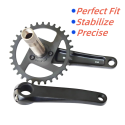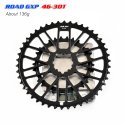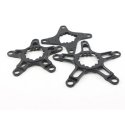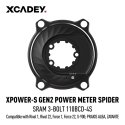JerseyJim
Guru
When I shared what I experienced on my first ride with 160 mm cranks, it never occurred to me that observations would be so controversial. Actually it seems that one observation in particular, my top speed on that day seems to threaten the perceptions of all who may want to try shorter cranks. This is despite the fact that I provided an explanation of the possible reason for the lower speed and also the foundational equation (Power = Torque x Angular Velocity) governing that explanation.I am not sure what your background is, but for reference, I am an engineer who is well trained in Physics and do hand calculations daily. I know the Physics related to this very well (which is actually high school level). You might too, but some things you say lead me to think not.
My background...I was a double major in college; Mechanical Engineering and Philosophy. Not only was physics a core part of my studies, so was the study of reason and argument. During that time I also worked as a tutor of high school and freshman physics. All my students did very well. Today I work in the civil engineering field. Mainly I design forming and shoring. This requires that I have to calculate loads and pressures and do my work within industry standards or structures may fall and/or people may get hurt. I have to provide those calculations to civil authorities so clients can get approval for the work. I've also done other things in my working life such as software system testing, software development and database administration. All of which require an analytical approach.
[Sound of tape measure retracting] Incidentally, my background, your background, or anyone else's background has nothing to do with this discussion. In logical argument, stating one's qualifications to bolster an argument is a logical fallacy called "Appeal to Authority". It's considered a logical fallacy because an argument turns on the facts, not who is speaking them.
A guy walks into a bar. He's soaking wet. There's another guy sitting at the bar. He says to him, "Wow, it's really raining hard out there". The guy at the bar replies "No, it's not raining." The first guy says "Yes it is, coming down in sheets. I'm soaking wet!" The guy at the bar says, "No, it's not raining. Trust me. I'm a meteorologist. If it were raining I would know".
I put that example in the form of a joke, but it's not funny. Facts don't change based on one's declared expertise. Too many people think it does.
From my first defense of my observations, I left the door open to my explanation being flawed. I also gave the foundational equation for my explanation and how it was applied. I have yet to see any equations in response or convincing argument which shows my understanding of the equation is in error.
What seems to be at the heart of this disagreement is that you cannot conceive of me doing a top speed run which results in a loss of top speed. I've explained that it was probably due to not being able to make up the the additional cadence required to make the same power. Apparently, this is not satisfactory.
Whenever scientists do experimental studies, they do more than one trial run. This is because one run can not be conclusive. One needs more data. When the group of runs is aggregated, one can then look for trends which can be compared against the model being tested.
If my ride was part of labwork and it was compared against other runs, it could be that the one data point is an anomaly. My lab director would want an explanation of the anomalous data point. If I provided an explanation that was within the parameters of the science being studied, it would be satisfactory and we would all move on. I've done that for my 2mph speed loss. I've also stated that I don't care about the speed loss but also stated what I would do if I did. I don't know why you care more than I do. Any reasonable person here won't be dissuaded from trying short cranks because of my one test run. If they are reasonable, they'll read my explanation of it and then try it for themselves.
What do I say about the car analogy? [eyes measuring tape] Look, I also have a sports car and a motorcycle and I've been a motorsports enthusiast all of my life. From drag racing to NASCAR to world rally championship to formula 1 and MotoGP, I love it all and I'm well aware of the power curve of all kinds of engines and motors as well as their interaction with transmission systems. The analogy to people as engines is not ridiculous. That's exactly how a human is viewed in a human powered vehicle system. A person is an engine that turns a crank. From a physics point of view, one is only concerned about the power generated, not who or what is generating the power (horses maybe?...horsepower?).
Now with respect to gear calculators and speed...Let's make one right here. Let's turn a wheel with a circumference of one meter. That means in one revolution it will travel 1 meter. If I can get that wheel to spin 1 revolution in 1 second, it's speed will be 1 meter per second.
Now let's put that wheel in a drivetrain where the input crank makes one revolution and the connected wheel makes 2 revolutions. If I turn the input crank one revolution in one second the wheel undergoes 2 revolutions in the same time. Since the circumference of the wheel is 1 meter, the wheel travels 2 meters for every revolution of the crank or in this case travels 2 meters in one second. This is the speed of that wheel because speed is distance over time. I can plug in any ratio for the input crank and calculate the speed of the wheel. I can turn the crank at a rate other than 1 revolution per second and the speed of the wheel will change accordingly. Conversely, you can also spin that wheel at a certain speed and calculate how fast the input crank will be turning.
Yes, on a bike car or whatever, the wheel speed will be an estimate of actual speed. All the weight, friction, drag, etc. has to be taken into account. However, this estimate will be close. Also based on my example here, your assertion that "Gear calculators do not tell you your speeds" is not consistent with the math. I just demonstrated that here.
This is the last I will say about my one and only high speed run on 160 mm cranks. I assure you that after all of my explanations, no one will be mislead regarding my conclusions, so you can rest easy. I also apologize to all of you for boring you with my educational and professional background as it has absolutely nothing to do with riding a bicycle or short cranks. If by chance anyone reading this now has been discouraged from trying shorter cranks (and I know I might be just by the tedium of this subject), I encourage those people to go do your own testing. Go get some short cranks and ride your bicycle, for that is the point of having a bicycle. Go ride! Have fun! Reach your own conclusions and for goodness sakes, don't listen to people on internet forums.







